(Written by William)
The LEGO Elves sets are known for their beautiful and magical color-scheme and fantasy elements, but they also provide some interesting building techniques that are worth discussing. When the first LEGO sets with mini-dolls were released back in 2012, they were built quite simply, and there was not much to talk about as far as techniques. This made sense at that time, as LEGO was trying to attract a new audience of young girls who were not familiar with LEGO. Since then, the LEGO mini-dolls line branched out to several different themes (LEGO Friends, LEGO Elves, LEGO Disney, LEGO Super Heroes, etc.) with enthusiastic fans who were now ready to tackle more sophisticated projects. Since I was very pleased with the previous LEGO Elves sets I had a chance to build, I thought I try another set from the collection. This time, we will be discussing the unique building techniques in the #41179 LEGO Elves Queen Dragon’s Rescue that was originally released in 2016. 🙂
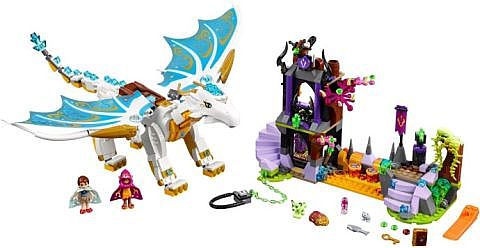
The main attraction and largest build in the #41179 LEGO Elves Queen Dragon’s Rescue is the queen dragon herself. While building it, I did not feel like anything was compromised or dumped down to cater to a younger audience. I even remarked to my wife how I thought the dragon was more aesthetically pleasing than the early LEGO Ninjago dragons. That’s not to say that either of them is better or worse, it’s just that the Ninjago dragons more focused on action and play-features, whereas the LEGO Elves dragon had a more finished and gentle look to it.
➡ ROTATION TO LINEAR MOVEMENT WITH LEGO
While building LEGO sets you may have noticed that most action and play features start out as some sort of rotating element. There are of course exceptions, but chances are that you will need some sort of rotating component to incorporate action features. This could be a fully rotating piece like a propeller or revolving door, or it could be a hinge that allows something to swivel. Rotating pieces are particularly efficient in providing some kind of action when space is limited. And we may not even need the full rotation of the piece to make an action feature work. For example, we may want something to move horizontal or vertical and the best way to achieve that is by using a rotating piece to initiate the action. The #41179 LEGO Elves Queen Dragon’s Rescue offers two examples of how we can achieve this type of motion.
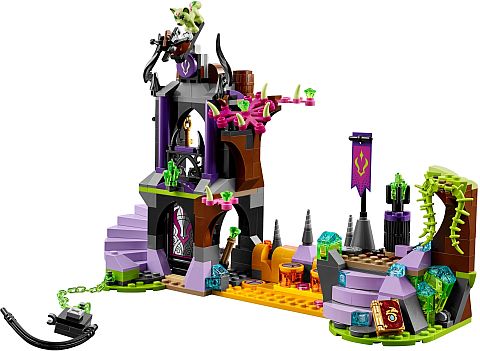
To exemplify horizontal movement using a rotating piece, let’s take a look at the lava flow in the #41179 LEGO Elves Queen Dragon’s Rescue, where a few magical bits are floating in a stream. The initial motion is provided by a rotating pillar, but how does that circular motion turn into a straight line?
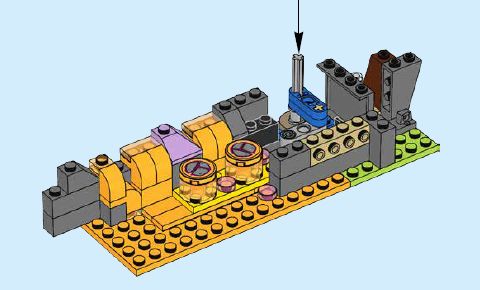
First of all, we need some sort of arm, that connects directly into the turning mechanism to help define the distance we can push/pull something. However, this alone is not enough. If we were to connect the floating lava stream to the arm, it would simply move in an arc rather than a full circle or a straight line. Therefore, we need some way to connect the arm to the moving piece without messing with the element’s direction. For the lava flow, a second arm is used to make this connection. By adding two additional joints, the arc motion is absorbed. The last step is to create a channel for the element, so that the motion is directed. A few bricks later, and you have something that moves left and right.
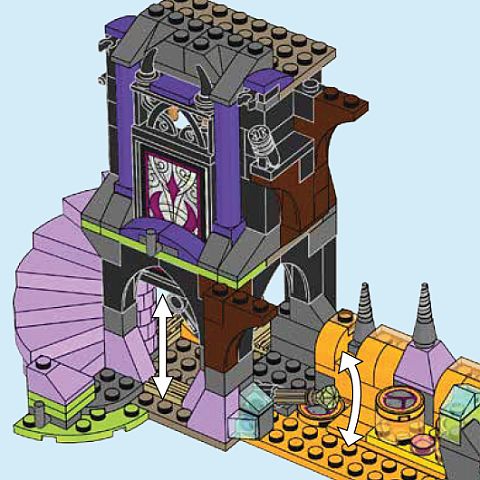
The same principle can be applied to vertical movement as well. The tower has a large glass window and fence section that can be moved up and down by a lever. The lever starts by rotating, and we once again see the arm that is attached to help define the distance. However, unlike for the horizontal movement, this time gravity is used as the connecting element. Since gravity forces the window to fall, it has to touch the arm. The only trick left is to make sure the arm will always touch the window, which is done by a specific angled connector. The window is then placed in a well-defined channel and it’s done. In the video below, you can see both functions built and demonstrated.
➡ JOINT RESISTANCE WITH LEGO
If you regularly build large LEGO animals or mechs, you know the challenges that come with building movable joints. They need to be light enough to hold up their own weight, but also sturdy enough to not fall apart. Besides juggling the balance between movement, weight, and fragility, there is another technique you can consider; adding resistance.
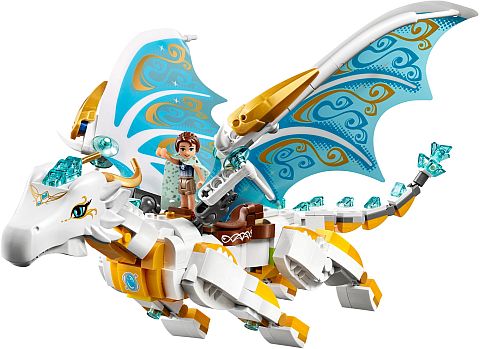
I was in the midst of building the body of the queen dragon when I noticed there were four axles coming out of the main frame. This was odd to me, as they looked like the type of setup used for attaching wheels when building cars. Things got even more interesting when each axle got a ball-joint, indicating that we are definitely building something with a lot of movement. But then the ball-joint receivers were clipped on, and something strange happened; the ball-joint receivers got locked into the frame. I started thinking, “Why go through all the trouble of creating a moving component and then lock it in?” But then I realized that LEGO designers used this technique, not for posability, but to add resistance for the rest of the axle that stuck out. Sure enough, the axles eventually got connected to the dragon’s legs. All of this added the necessary resistance to let the dragon strike interesting poses without falling in on itself.
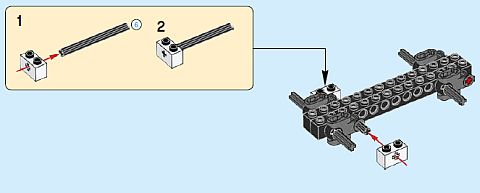
Adding resistance is not a new concept for me. I know if I use a clip and bar connection, for instance, something could easily move, and if I add a whole series of clips and bars the movement would become much stiffer. However, this was the first time I saw a single piece used primarily for a secondary characteristic it just happened to have. You look at a ball-joint and tend to think about the wide range of motion it can provide. It won’t cross many people’s minds to think that it will offer a lot of resistance. But, that’s exactly what’s done in this set. The downside of this technique is that it needs a decent amount of space to build it properly. However, most models that require this amount of resistance will likely be quite large anyway.
➡ APPLYING WHAT YOU LEARN
I have to admit that I’m terrible at figuring out how to make things move a certain way. This is why I really liked how the #41179 LEGO Elves Queen Dragon’s Rescue provided two interesting ways that I can learn from. The concept used isn’t hard to apply and, by doing the same thing in two different ways, it shows the inherent versatility the technique has. Hopefully, you find it to be useful as well.
As far as using resistance when building joints, I wish I knew about this technique sooner. I built a large figure for the first time, and had all sorts of issues making the arms work. The legs were even worse, so I ended up making them solid. Now I see that by adding resistance, I can make a much more reliable figure without having to give up anything (apart from the interior space needed for the technique). Generally, this technique is going to be most useful for large figure sculptures, but you might also consider it when dealing with an element that wiggles around too much and needs some added stability.
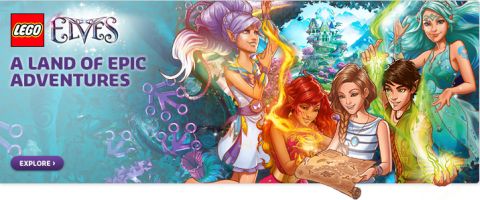
If you want to experiment with LEGO Elves dragons, the #41179 LEGO Elves Queen Dragon’s Rescue is no longer available directly from LEGO, but there are some other LEGO Elves sets with large dragons you can check out under the LEGO Elves section of the Online LEGO Shop.
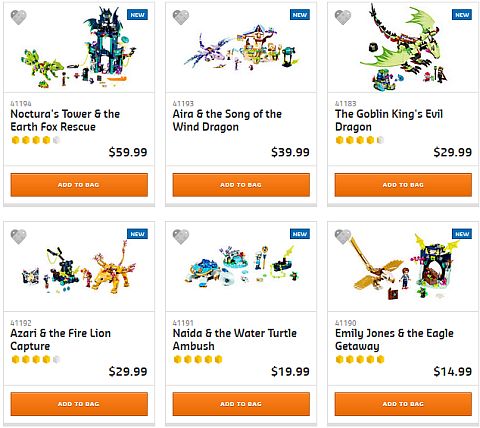
What do you think? Have you run into the techniques discussed here in other sets as well? And did you use them in your own creations? Feel free to share your thoughts and discuss in the comment section below! 😉
And you might also like to check out the following related posts:












I’m very tempted to get this theme but, I have to draw the line somewhere . I did get some of the earlier sets but, I decided to focus on other sets. Right now I’m trying to save up for the Avengers Sanctum Santorum building set.
Yeah, there are definitely lots of great sets to choose from. It’s always a tough call to decide…
I can’t get over how beautiful the dragons are! I wonder if they could make similarly beautiful other creatures.
Take a look at the most recent releases. It includes a turle, a fox, and a lion in the same style. 😉
I heard some rumors that Elves may get discontinued. Is that true?
Some fans are worried about it as no Elves sets were displayed at the Toy Fairs. It’s hard to tell one way or another at this point. I know that there are at least two other sets coming.
It’s been a pretty cool theme, so far.
There are at least two new Elves sets coming in the summer! They weren’t shown at the New York Toy Fair though because across all the themes they only showed a handful of sets for the second half of the year. A lot of big toy companies seem to be getting more secretive with their Toy Fair booths.
After that, no way to know for sure. I hope it continues but I also think this year’s sets would make for a pretty amazing final battle if LEGO did want to wrap things up!
They’re listed on Bricklink under the names
41195: Emily & Noctura’s Showdown
41196: The Elvenstar Tree Bat Attack .
Although I haven’t bought a lot of sets, I like the style. One of my favorite themes from the last years, along with Nexo Knights and Ninjago Movie …
Got to catch them all POKEMON… sorry got distracted.. this is a must have theme.. if the latest set of Elves is their last. will get them and have all in the Lego elf series..
given up on the Lego theater… such a downer… just got the fishing boat set Epic.. can’t wait for the ninjago Barbour… the rest is meh.. in my book.. however different people different taste.
at least it is not an army of Rainbow Dash, and i love how you can mix and create with Lego… totally worth it..
Batman not sure.. maybe maybe not, do not have the Bane set with his vehicle.. might get that one if it goes on sale..
Great write up! The axle through the ball joint technique blew my mind when I was building this set. I hope Elves stays around for a long time!
Hey, Dave, nice to have you over! Yes, I also hope Elves will continue inspiring us with lots of magic! 🙂
Looks like I’m going to have to try this out. I’m curious about that leg locking mechanism.
Some of the generation 2 Bionicle sets like Onua Master of Earth and Ekimu the Mask Maker also used ball joints just to add friction, similar to how this set and The Goblin King’s Evil Dragon do. Not only does it make a pretty sturdy joint, it’s also great if you want to rebuild the set into something else since you still have the option of using the ball joints normally if you prefer!
Elandra the Queen Dragon is definitely my favorite LEGO dragon ever, and the LEGO Elves creatures in general have a really beautiful and lifelike look.
The function with the sliding lava columns is also fun. I love how LEGO Elves sets use play features like this to create the sense of the elves using their magic to interact with the environments around them!
Has the Lego Super Hero Girls Theme been cancelled? It was crossed out in the article and there was no new sets out at the beginning of this year is why I ask. If they have been cancelled then the money used for those sets will definitely be used to get more Elf sets.
Matt, I have not heard anything about Super Hero Girls. As you said, there has been no new sets, and no news from the toy fairs either. It is quite possible that the theme has been discontinued.
Oh, yeah, pretty decent theme, otherwise. A shame we haven’t gotten around to any Katana sets…
https://en.wikipedia.org/wiki/Katana_(comics)
https://en.wikipedia.org/wiki/DC_Super_Hero_Girls